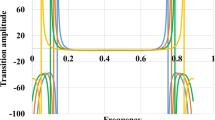Abstract
Transition probabilities per time unit in the spectrum of the hydrogen atom confined in a spherical cavity are studied with the Dirac equation. The calculations are performed with simple and accurate expansions of the Dirac components provided by the Lagrange-mesh method with small numbers of scaled Jacobi mesh points. The initial and final states as well as intermediate states occurring in two-photon transitions are described with a single Lagrange mesh. With this simplification, accurate matrix elements are easily computed with the Gauss quadrature associated with the Lagrange–Jacobi mesh. One-photon transitions are considered from the \(n = 2\) and 3 levels. Most transition probabilities increase as a negative power of the confinement radius when it becomes small. The two-photon \(2s_{1/2}-1s_{1/2}\) transition stops being the main deexcitation channel of the \(2s_{1/2}\) level when the confinement radius decreases below about 15 atomic units. The \(2p_{1/2}\) and \(2p_{3/2}\) levels come below the \(2s_{1/2}\) level and allow a faster one-photon deexcitation.




Similar content being viewed by others
References
A. Michels, J.D. Boer, A. Bijl, Physica 4, 981 (1937)
L.G. Jiao, L.R. Zan, Y.Z. Zhang, Y.K. Ho, Int. J. Quantum Chem. 117, e25375 (2017)
H. Olivares-Pilón, S.A. Cruz, Int. J. Quantum Chem. 117, e25399 (2017)
R.A. Rojas, N. Aquino, A. Flores-Riveros, Int. J. Quantum Chem. 118, e25584 (2017)
N. Aquino, G. Campoy, H.E. Montgomery, Int. J. Quantum Chem. 107, 1548 (2007)
N. Aquino, R.A. Rojas, Few-Body Syst. 61, 16 (2020)
D. Baye, Int. J. Quantum Chem. 119, e26034 (2019)
D. Baye, P.-H. Heenen, J. Phys. A 19, 2041 (1986)
M. Vincke, L. Malegat, D. Baye, J. Phys. B 26, 811 (1993)
D. Baye, M. Hesse, M. Vincke, Phys. Rev. E 65, 026701 (2002)
D. Baye, Phys. Rep. 565, 1 (2015)
D. Baye, L. Filippin, M. Godefroid, Phys. Rev. E 89, 043305 (2014)
L. Filippin, M. Godefroid, D. Baye, Phys. Rev. A 90, 052520 (2014)
L. Filippin, M. Godefroid, D. Baye, Phys. Rev. A 93, 012517 (2016)
D. Baye, M. Hesse, J.-M. Sparenberg, M. Vincke, J. Phys. B 31, 3439 (1998)
E. Tiesinga, P.J. Mohr, D.B. Newell, B.N. Taylor, Rev. Mod. Phys. 93, 025010 (2021)
I.P. Grant, Relativistic Quantum Theory of Atoms and Molecules (Springer, New York, 2007)
W.R. Johnson, Atomic Structure Theory (Springer, Berlin, 2007)
I.P. Grant, J. Phys. B 7, 1458 (1974)
J.P. Santos, F. Parente, P. Indelicato, Eur. Phys. J. D 3, 43 (1998)
P. Amaro, J.P. Santos, F. Parente, A. Surzhykov, P. Indelicato, Phys. Rev. A 79, 062504 (2009)
M. Abramowitz, I.A. Stegun, Handbook of Mathematical Functions (Dover, New York, 1965)
S.P. Goldman, G.W.F. Drake, Phys. Rev. A 24, 183 (1981)
P. Amaro, A. Surzhykov, F. Parente, P. Indelicato, J.P. Santos, J. Phys. A 44, 245302 (2011)
G.W.F. Drake, Phys. Rev. A 34, 2871 (1986)
G. Szegö, Orthogonal Polynomials (American Mathematical Society, Providence, 1967)
D. Baye, J. Phys. B 28, 4399 (1995)
U.D. Jentschura, A. Surzhykov, Phys. Rev. A 77, 042507 (2008)
D. Baye, K.D. Sen, Phys. Rev. E 78, 026701 (2008)
Acknowledgements
This work was supported by the Fonds de la Recherche Scientifique - FNRS under Grant Number 4.45.10.08.
Author information
Authors and Affiliations
Corresponding author
Additional information
Publisher's Note
Springer Nature remains neutral with regard to jurisdictional claims in published maps and institutional affiliations.
Nonrelativistic Treatment
Nonrelativistic Treatment
Nonrelativistic transition probabilities can be calculated in two different ways. First, the electric matrix elements (9) are computed with \(I_L^\pm = 0\) and
where \(u_l(r)\) is a radial wave function obtained from the Schrödinger equation. Second, the integral \(J_L\) is calculated at the long-wavelength approximation, i.e. with \(j_L(\alpha \omega r)\) replaced by the first term of its Taylor expansion,
Both options are considered below.
The relativistic results of Table 2 summed over the final j values are compared in Table 4 with both types of nonrelativistic transition probabilities. The Schrödinger equation is solved with expansions in shifted Lagrange–Legendre functions regularized at 0 and 1 in the confined case [11, 29] and in Lagrange–Laguerre functions regularized at the origin in the free case [10, 11]. The probabilities are obtained from integrals (A1) and (A2) computed with the corresponding Gauss quadrature.
For \(R = 0.1\) and 1, the nonrelativistic results are larger than the relativistic ones but one observes the opposite at \(R = \infty \). The long-wavelength approximation is a little larger than the calculation with (A1), as expected. For \(R = 0.1\), the nonrelativistic results are about 20 % larger than the relativistic ones. At \(R = 1\), the difference decreases to about 0.2 %. For \(R = 10\), both results are quite close. Beyond \(R \approx 9\), the relativistic values become larger than those with obtained with (A1) and, beyond \(R \approx 12.5\), they become the largest. For the free hydrogen atom, the long-wavelength analytical value \(W(2p \rightarrow 1s) = 2^8 \alpha ^4 c/3^8 a_0\) is reproduced by the mesh calculation for all presented digits. The comparison between the results for the \(2s \rightarrow 2p\) transition is mostly influenced by the size and variations of the energy gaps between the 2p and 2s levels in both treatments.
In Table 5, nonrelativistic 2E1 transition probabilities are compared with results of Table 3. The long-wavelength expression for \(W(2s \rightarrow 1s)\) is equivalent to Eqs. (12) and (14) of Ref. [25]. With the conditions of Ref. [25], I obtain 8.229381045632 in agreement with Drake’s extrapolated value 8.22938104. For \(R = 20\) and \(\infty \), the nonrelativistic result is larger by \(1.3 \times 10^{-4}\) than the relativistic one and, at the long-wavelength approximation, by \(2.9 \times 10^{-4}\).
Rights and permissions
About this article
Cite this article
Baye, D. Electromagnetic Transitions in the Spectrum of a Confined Hydrogen Atom. Few-Body Syst 63, 33 (2022). https://doi.org/10.1007/s00601-022-01732-6
Received:
Accepted:
Published:
DOI: https://doi.org/10.1007/s00601-022-01732-6



